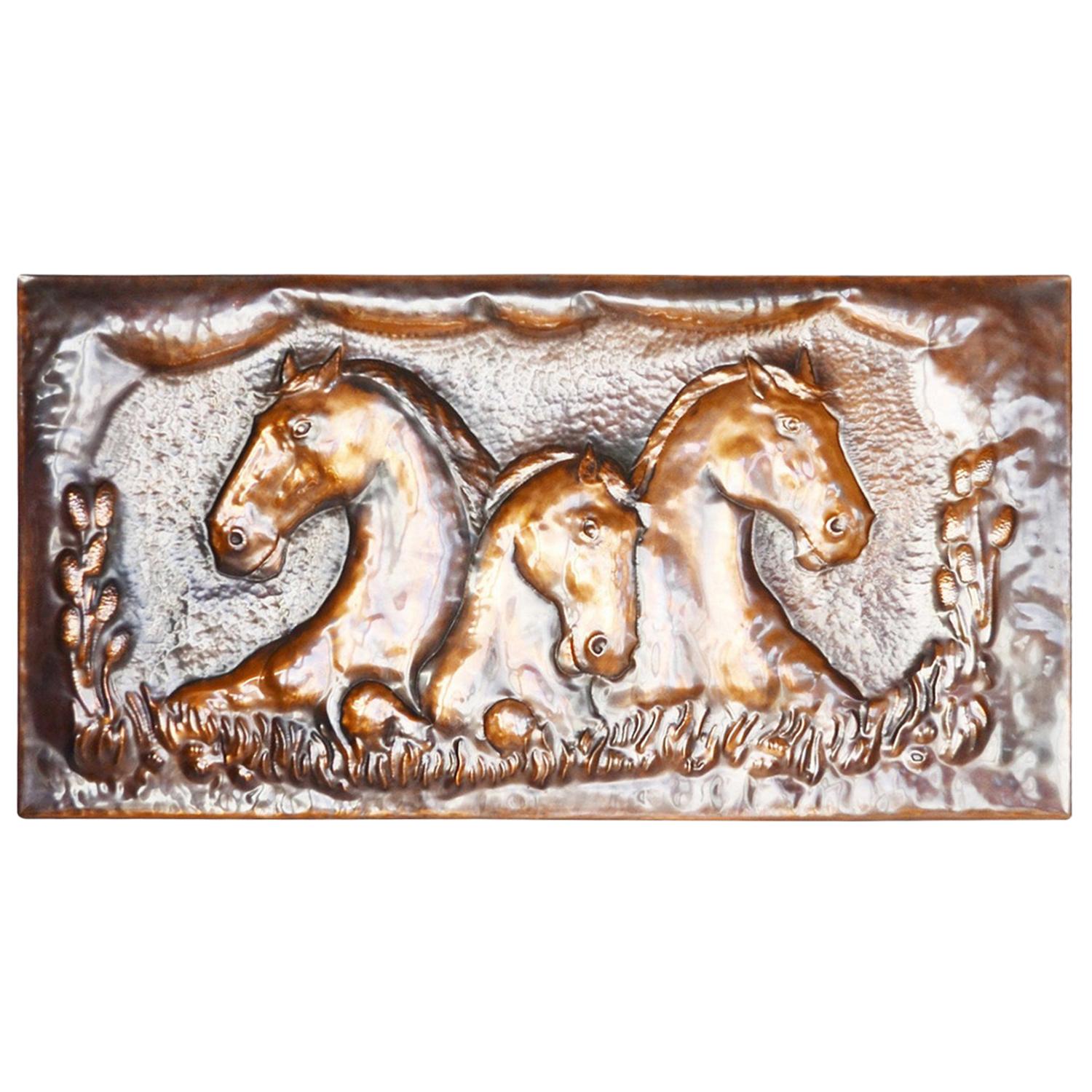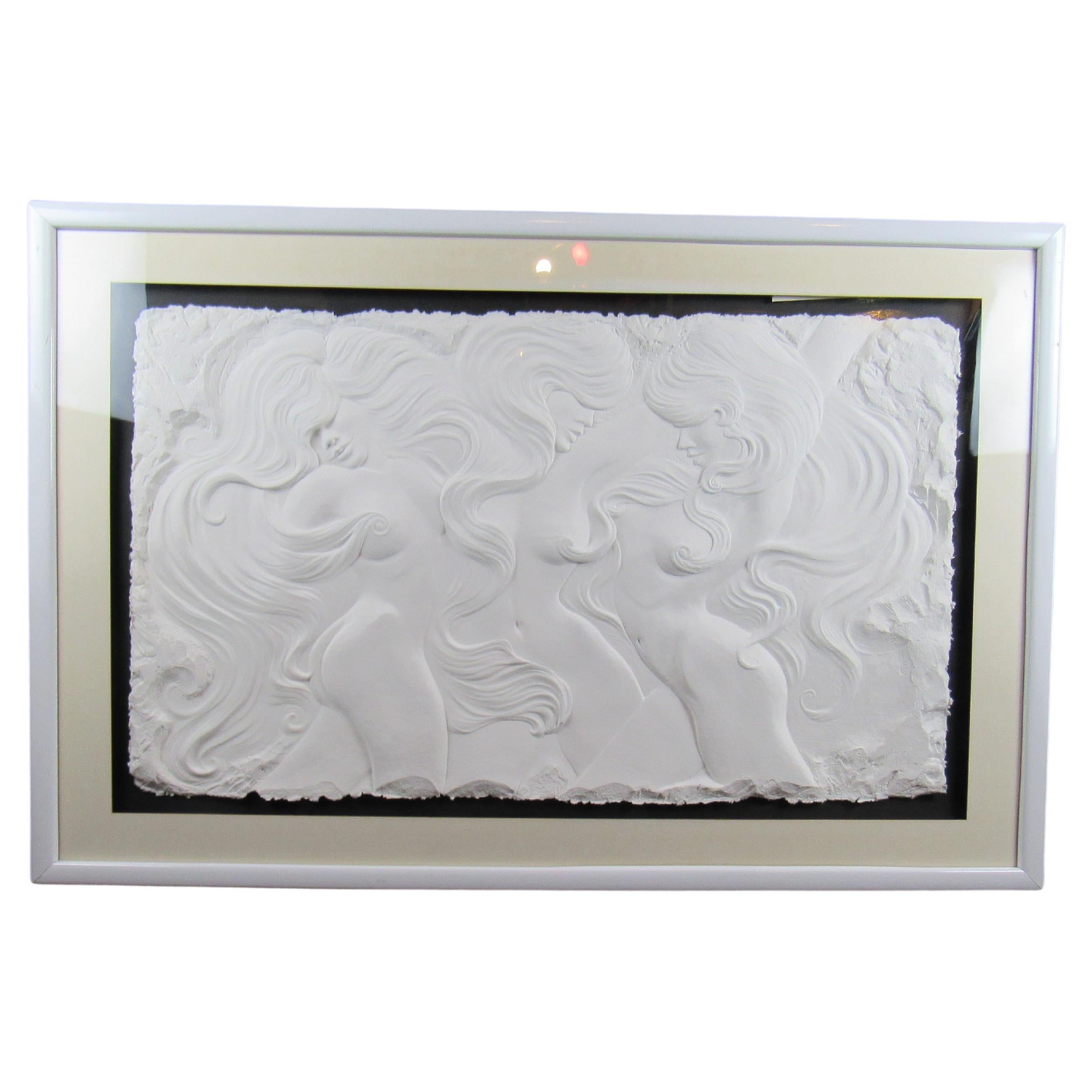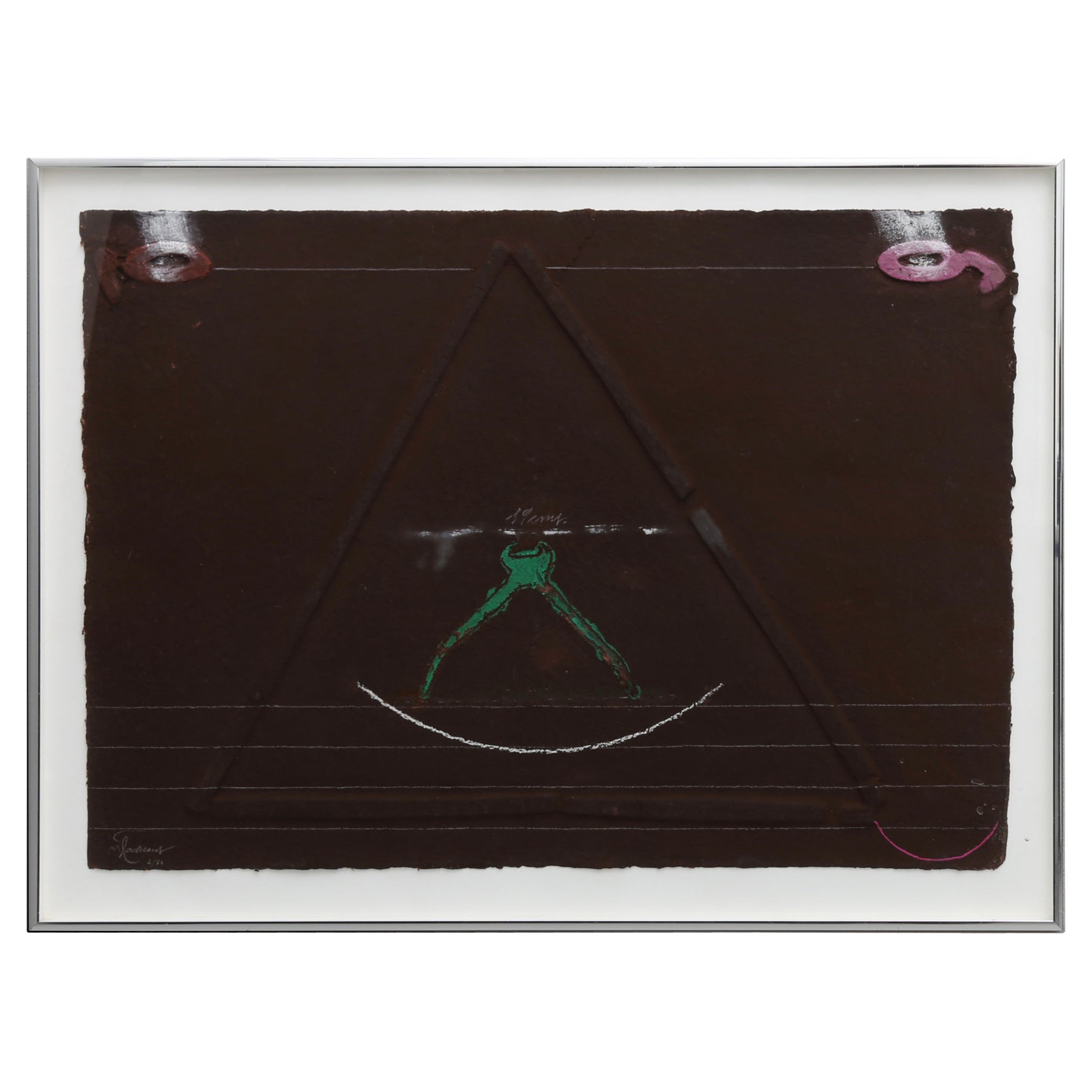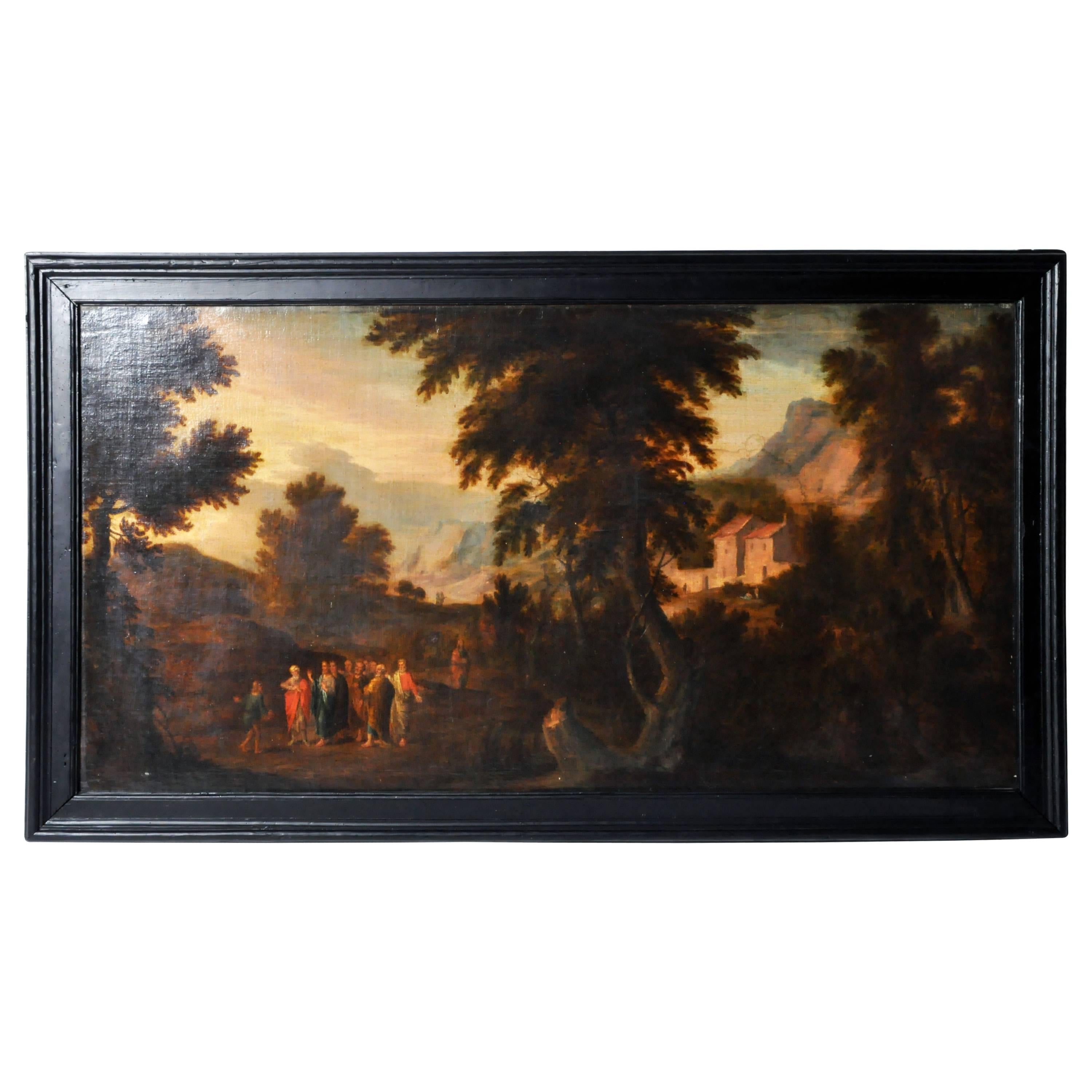Items Similar to Rare early Embossed gilt leather, mythological hunting scene.
Want more images or videos?
Request additional images or videos from the seller
1 of 12
Rare early Embossed gilt leather, mythological hunting scene.
About the Item
Publisher: Jacob & Abraham Hamer, “De Gecroonde Son” Amsterdam
Place / Date: Amsterdam, ca. 1660
Two original 17th c. pendant panels of 'verheven leer' or gilt embossed leather [the embossing executed w. the help of metal plates carrying the iamge], measuring 72 x 60 cm each, on which the motif of Atalantha (accompanied by a nymph) and Meleager hunting down the wild boar roaming the Caledonia forest. Meleager offers the boar's head to Atalanta, electing her Queen of the hunt. The embossed leather applied w. silver and double varnished [w. a sandarac varnish] in gold, resulting in a beautiful soft brown-golden hue. The 3 central figures, the birds, flowers, fruits and plants, grapes, hunting dogs, stags, huntsmen, and the boar, all painted after varnishing in a rich pallet of greens, yellows, and reds. The winding leaf ranks left and right w. the central portion in green and gilt leaf borders. 1 putto [Cupid w. bow and arrow?] at the top lefthand corner, two small heads of angels at the lower margin. The nymph accompanying Atalanta w. spear, Atalanta herself w. bow, 2 dogs at her feet. Her head was crowned w. a wreath with four blossoming flowers held by a dove, a token of awakening love. Half hidden in the flowering ranks, we see huntsmen, stags & hunting dogs.
Amsterdam, gilt leather manufacturers Jacob en Abraham ‘de Gecroonde Son’ Hamer; De Gecroonde Son / or ‘De Vergulde Roemer’, Pieter van Dam, Jacob van Ipen, Pieter Potter. Date appr. 1660 – 1680 [see Koldeweij]. These 2 smaller panels measure appr. 72 x 60 each, together 72 x 120 cm. In a modern metal and wooden frame, the frame itself covered w. brown leather corners are a little damaged. The two panels are mounted on the modern dark calf., parts of the mounted gilt leather w. small losses, a.o. at outer extremities.
These panels were preserved in 1985 after the restoration of a 3 screen divider for the Rijksmuseum by the renowned gilt leather restorer Hendrik van Soest, then working for the Centraal Laboratorium. 9 panels were used for this 3 screen divider, w. the same hunting scene, but in brighter colors and w. the leaf ranks’ central portion fully gilded and bright, obscuring the details. 1 partial panel in similar colors as the 2-panel one described here, showing 'Meleager' only was left [75 x 57 cm] and idem a small strip [leaf rank only, green central portion] meas. 77 x 28 cm. Now also in the Rijksmuseum. The remaining panels, with the complete hunting scene, here described, were restored and framed by H.A.B. van Soest for Max Israel. From his estate to auction. To present owner.
Very well preserved. Beautiful and fresh colors on dark fond, stunning details.
- Creator:Jean-Pierre Hamer (Maker)
- Dimensions:Height: 30.71 in (78 cm)Width: 51.19 in (130 cm)Depth: 1.19 in (3 cm)
- Style:Dutch Colonial (Of the Period)
- Materials and Techniques:Leather,Amsterdam School
- Place of Origin:
- Period:
- Date of Manufacture:1660
- Condition:Replacements made: Restored and framed in 1985, by H.A.B. van Soest who worked for the Amsterdam Rijksmuseum. Repaired: some repairs in certain areas where the original leather has been replaced. Minor structural damages.
- Seller Location:ZWIJNDRECHT, NL
- Reference Number:1stDibs: LU9419237684852
About the Seller
No Reviews Yet
Vetted Seller
These experienced sellers undergo a comprehensive evaluation by our team of in-house experts.
1stDibs seller since 2023
- ShippingRetrieving quote...Ships From: ZWIJNDRECHT, Netherlands
- Return PolicyA return for this item may be initiated within 14 days of delivery.
More From This SellerView All
- A pair of extremely rare Valk table globesBy Gerard and Leonard ValkLocated in ZWIJNDRECHT, NLTitle on the globes: VALK, Gerard and Leonard. [Terrestrial globe:] Cosmotheore, caelesti nostro globo, par, et plane novus, hic terrestris ut existeret, certo scias, errore veterum ...Category
Antique 18th Century Dutch Dutch Colonial Globes
MaterialsOther
- An extremely rare pair of miniature globes by Johann Baptist HomannBy Johann Baptist HomannLocated in ZWIJNDRECHT, NLJ.H. Homann (Germany, 1664-1724) Nürnberg, after 1715 Globus Terrestris [and] Globus Celestis. juxtu observationes Parisienses Regia Academia Scientiarum constructus [and] juxtu observationes Parisienses Regia Academia Scientiarum constructus. Nuremberg, [after 1715]. Original stands by Homann Heirs, [after 1730]. An extremely rare pair of terrestrial and celestial globes, each with 12 hand-coloured engraved paper gores, over a papier mâché and plaster sphere, each globe with papier mâché meridian ring, mounted on horizon rings with a handwritten number VIII and III on each globe. The horizon rings supported by four quadrants with text "Zu finden in Nürnberg / wohnhaft unter der Vesten / bey denen Homaenischen Erben/ dem Prediger Klöster gegenüber", both globes on a turned single wooden black stand. Diameter 64 mm (2.5 inches), height 185 mm. RARE. Johann Baptist Homann (1664–1724), a German geographer and cartographer. He founded a publishing business in Nürnberg in 1702, and published his first atlas in 1707, becoming a member of the Academy of Sciences in Berlin in the same year. Homann was appointed Imperial Geographer to Charles VI in 1715 and became the most important map...Category
Antique 1710s German Dutch Colonial Globes
MaterialsOther
- A decorative pair of rare table globes in a fine condition.By Johann Gabriel DoppelmayrLocated in ZWIJNDRECHT, NLThese pair of globes, dated 1730, are original and in fine condition. Title: Globus terrestris novus Loca Terrae insigniora sec. praestant Astron. et Geogr. observationes sistens op...Category
Antique Early 18th Century German Baroque Globes
MaterialsOther
- An exceptional pair of BLAEU table globesBy Willem BlaeuLocated in ZWIJNDRECHT, NLA very rare set of globes, 9 inch / 23cm, with an overall height of 38 cm, Amsterdam, dated 1602, but published after 1621. In their original stands with circular wooden horizon rings, covered with printed paper, supported by four legs and brass meridian rings supported by a single column. The terrestrial and celestial globe are made up of a set of 12 engraved gores, heightened in gold and Arctic ice caps, printed on paper and mounted on a plaster sphere of papier maché. Each sphere is mounted in a graduated brass meridian ring with the production number stamped at the back of the ring. Both globes are mounted on four-legged ebonized oak Dutch stands, which support the horizon ring. The legs are connected by two crossbeams which support a circular base plate with central support for the meridian ring. The horizon rings are covered with printed paper. With usual defects: paper equinoctial tables present gaps that are filled and restored; small splits along gores; several partially deleted entries; on the globe, the date 1602 and the text of the cartouche in America, are illegible ; small scattered spots but in general in good condition for such an early globe pair of which presently only 19 pair are recorded. These 9-inch globes are among the rarest since very few copies of them are known to exist, in comparison with the smaller or larger globes of Blaeu (4, 6, 13.5, and 26 inches). Blaeu's terrestrial globes were highly valued and were much in demand, because of the care with which they had been prepared, because of the efforts to give the latest information on discoveries, and because of the loxodromic lines that made them of special value to navigators. His celestial globes were appreciated for the fact that he had been the pupil of Tycho Brahe, who was himself known to be the greatest astronomer of his time. Willem Janszoon Blaeu (1571–1638), originally trained in astronomy, he quickly became a leading maker of maps, atlases and instruments. Blaeu’s globes were luxury items for wealthy and intellectual merchants and nobility who benefited from Blaeu’s access through the Dutch East India Company to the latest navigational discoveries and geographical information. Willem Jansz Blaeu collected information that Dutch mariners gathered from around world and brought back to Amsterdam. Crews were instructed to record information about the lands they visited and the skies they saw. Blaeu incorporated these observations in maps and globes. Through his web of contacts and thanks to assiduous research, he was also able to obtain the most recent information about the latest discoveries in the western hemisphere and the South Pacific, where Dutch explorers were particularly active at the time. Since the globe was published after 1618, Blaeu was able to include the discoveries made by Henry Hudson in his attempt to find a passage to the East Indies. He also included recent Pacific discoveries of the celebrated voyages of Willem Cornelis Schouten and Jacob Le Maire, who both traversed the South Pacific and the Atlantic. The findings of Schouten and Le Maire in the Tierra del Fuego region are also incorporated. The Strait of Le Maire is drawn and the hypothetical southern continent is labelled “Terra Australis Incognita Magalanica”. Olivier van Noort’s track is drawn and labelled. His route is indicated with a broken line and the words: “Navigationis Olivierij ductus” (several times). There are various decorative features, such as animals on the different continents, many ships on the high seas and allegorical and mythical figures around the cartouches. The nine-inch globe is not just a smaller version of the one published in 1599. Drawings of animals and people do often correspond to those on the earlier globe, but Blaeu made several significant changes. - The west coast of North America is drawn differently and the river system of Brazil is altered. - The hypothetical southern continent is labelled: Terra Australis Incognita Magallanica. - There are nine ocean names in handsome curling letters: Mare Congelatum, Mare Atlanticum, Oceanus Aethiopicus, Mare Arabicum et Indicum, Mare di India, Oceanus Chinensis, Mar del Zur, Mare Pacificum, Mar del Nort. - Willem Blaeu...Category
Antique 17th Century European Dutch Colonial Globes
MaterialsOther
- Dutch Luther Bible with fine hand-coloured and highlighted in gold illustrationsBy Claes Jansz. Visscher (II)Located in ZWIJNDRECHT, NLBeautifully bound mid-17th-century "Visscher edition" of the Dutch Luther Bible with expertly hand-coloured and highlighted in gold illustrations. [BIBLE - LUTHER - DUTCH]. VISSCHER...Category
Antique 1640s Dutch Dutch Colonial Books
MaterialsGold
- Hand-coloured set of Buffon’s Histoire naturelle in its most luxurious formBy Georges-Louis Leclerc, Comte de BuffonLocated in ZWIJNDRECHT, NLPublisher: Buffon, Georges-Louis Leclerc de Place / Date: Dordrecht, Abraham Blussé, 1766-1799 Size: 38 parts in 21 volumes. Large 4to. With more than 1100 hand-coloured engraved ...Category
Antique Late 18th Century Dutch Dutch Colonial Books
MaterialsPaint, Paper
You May Also Like
- Early 1900s Embossed 'Slow Children' SignLocated in Los Angeles, CAExtremely rare California ‘Slow Children' playing sign. Entire sign is embossed with an old-time child wearing knickerbocker trousers. From the early 1900s. Great piece of history. P...Category
Early 20th Century American Contemporary Art
MaterialsSteel
- Large Equestrian Embossed Copper PlaqueLocated in Forest Row, East SussexA large equestrian embossed copper plaque. Rectangular plaque with the heads of three rearing horses, surrounded by meadow detail. Dimensions: H 55cm...Category
21st Century and Contemporary English Contemporary Art
MaterialsCopper
- Eye-Catching Embossed Paper NudesLocated in Brooklyn, NYTurn heads in any room with this gorgeous embossed paper artwork. A substantial 58"x39" frame is sure to make these ladies the focal point of your galle...Category
Mid-20th Century Mid-Century Modern Decorative Art
MaterialsPaper
- JOAN-PERE VILADECANS, mixed media with embossingLocated in Long Island City, NYJOAN-PERE VILADECANS ( Spain , born 1948) mixed media with embossing on paper. Numbered 4/74 and signed by artist. Framed, no glass on frame.Category
Vintage 1970s Spanish Modern Contemporary Art
MaterialsPaper
- Flemish Painting of "Pastoral Scene"Located in Chicago, ILThis Flemish painting of "Pastoral Scene" is from Belgium and is made from oil on canvas, 18th century. Flemish paintings flourished from the early 1...Category
Antique 18th Century Belgian Paintings
MaterialsCanvas
- French Country Scene Lithograph SignedBy Henri MartinLocated in Miami, FLA beautiful and colorful lithograph that would enhance any space. Professionally framed and signed. This very good quality colorful lithograph of a French countryside will enhance...Category
20th Century French Prints
MaterialsPaper
Recently Viewed
View AllMore Ways To Browse
Leather Carry All
Hunting Decorations
Gilt Metal Decoration
Embossed Wall Art
Antique Dutch Wall Art
Hunting Wall Art
Yellow Metal Wall Art
Hunting Panel
Hunt Scene Furniture
Jacob 17th
17th Century Colonial
Mythological Framed
Small Hunting Scene
Wooden Grapes
Gold Leaf Wall Panels
Wall Art Arrow
Embossed Leather Panel
Wild Hunt





